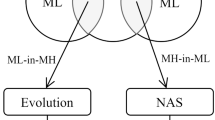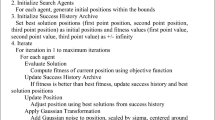Abstract
Indirect encoding is a promising area of research in machine learning/evolutionary computation, however, it is rarely able to achieve performance on par with state of the art directly encoded methods. One of the most important properties of indirect encoding is the ability to control exploration during learning by transforming random genotypic variation into an arbitrary distribution of phenotypic variation. This gives indirect encoding a capacity to learn to be adaptable in a way which is not possible for direct encoding. However, during normal objective based learning, there is no direct selection for adaptability, which results in not only a missed opportunity to improve the ability to learn, but often degrading it too. The recent meta learning algorithm MAML makes it possible to directly and efficiently optimize for the ability to adapt. This paper demonstrates that even when indirect encoding can be detrimental to performance in the case of normal learning, when selecting for the ability to adapt, indirect encoding can outperform direct encoding in a fair comparison. The indirect encoding technique Hypernetwork was used on the task of few shot image classification on the Omniglot dataset. The results show the importance of directly optimizing for adaptability in realizing the powerful potential of indirect encoding.
Access this chapter
Tax calculation will be finalised at checkout
Purchases are for personal use only
Similar content being viewed by others
References
Altenberg, L., et al.: The evolution of evolvability in genetic programming. Adv. Genet. Program. 3, 47–74 (1994)
Antoniou, A., Edwards, H., Storkey, A.: How to train your MAML. arXiv preprint arXiv:1810.09502 (2018)
Assunção, F., Lourenço, N., Machado, P., Ribeiro, B.: Using GP Is NEAT: evolving compositional pattern production functions. In: Castelli, M., Sekanina, L., Zhang, M., Cagnoni, S., García-Sánchez, P. (eds.) EuroGP 2018. LNCS, vol. 10781, pp. 3–18. Springer, Cham (2018). https://doi.org/10.1007/978-3-319-77553-1_1
Brown, T.B., et al.: Language models are few-shot learners. arXiv preprint arXiv:2005.14165 (2020)
Choromanska, A., Henaff, M., Mathieu, M., Arous, G.B., LeCun, Y.: The loss surfaces of multilayer networks. In: Artificial Intelligence and Statistics, pp. 192–204 (2015)
Clune, J., Ofria, C., Pennock, R.T.: How a generative encoding fares as problem-regularity decreases. In: Rudolph, G., Jansen, T., Beume, N., Lucas, S., Poloni, C. (eds.) PPSN 2008. LNCS, vol. 5199, pp. 358–367. Springer, Heidelberg (2008). https://doi.org/10.1007/978-3-540-87700-4_36
Clune, J., Ofria, C., Pennock, R.T.: The sensitivity of HyperNEAT to different geometric representations of a problem. In: Proceedings of the 11th Annual Conference on Genetic and Evolutionary Computation, pp. 675–682 (2009)
Fernando, C., et al.: Convolution by evolution: differentiable pattern producing networks. Proc. Genet. Evol. Comput. Conf. 2016, 109–116 (2016)
Finn, C., Abbeel, P., Levine, S.: Model-agnostic meta-learning for fast adaptation of deep networks. arXiv preprint arXiv:1703.03400 (2017)
Gajewski, A., Clune, J., Stanley, K.O., Lehman, J.: Evolvability ES: scalable and direct optimization of evolvability. In: Proceedings of the Genetic and Evolutionary Computation Conference, pp. 107–115 (2019)
Gauci, J., Stanley, K.O.: A case study on the critical role of geometric regularity in machine learning. In: AAAI, pp. 628–633 (2008)
Glorot, X., Bengio, Y.: Understanding the difficulty of training deep feedforward neural networks. In: Proceedings of the Thirteenth International Conference on Artificial Intelligence and Statistics, pp. 249–256 (2010)
Ha, D., Dai, A., Le, Q.V.: Hypernetworks. arXiv preprint arXiv:1609.09106 (2016)
Hansen, N., Ostermeier, A.: Adapting arbitrary normal mutation distributions in evolution strategies: the covariance matrix adaptation. In: Proceedings of IEEE International Conference on Evolutionary Computation, pp. 312–317. IEEE (1996)
Hausknecht, M., Lehman, J., Miikkulainen, R., Stone, P.: A neuroevolution approach to general atari game playing. IEEE Trans. Comput. Intell. AI Games 6(4), 355–366 (2014)
Huizinga, J., Clune, J., Mouret, J.B.: Evolving neural networks that are both modular and regular: hyperneat plus the connection cost technique. In: Proceedings of the 2014 Annual Conference on Genetic and Evolutionary Computation, pp. 697–704 (2014)
Huizinga, J., Stanley, K.O., Clune, J.: The emergence of canalization and evolvability in an open-ended, interactive evolutionary system. Artif. Life 24(3), 157–181 (2018)
Lake, B., Salakhutdinov, R., Gross, J., Tenenbaum, J.: One shot learning of simple visual concepts. In: Proceedings of the Annual Meeting of the Cognitive Science Society, vol. 33 (2011)
Mengistu, H., Lehman, J., Clune, J.: Evolvability search: directly selecting for evolvability in order to study and produce it. Proc. Genet. Evol. Comput. Conf. 2016, 141–148 (2016)
Pigliucci, M.: Is evolvability evolvable? Nat. Rev. Genet. 9(1), 75–82 (2008)
Risi, S., Stanley, K.O.: Enhancing ES-hyperneat to evolve more complex regular neural networks. In: Proceedings of the 13th Annual Conference on Genetic and Evolutionary Computation, pp. 1539–1546 (2011)
Salimans, T., Ho, J., Chen, X., Sidor, S., Sutskever, I.: Evolution strategies as a scalable alternative to reinforcement learning. arXiv preprint arXiv:1703.03864 (2017)
Song, X., Gao, W., Yang, Y., Choromanski, K., Pacchiano, A., Tang, Y.: ES-MAML: Simple hessian-free meta learning. arXiv preprint arXiv:1910.01215 (2019)
Stanley, K.O.: Compositional pattern producing networks: a novel abstraction of development. Genet. Program. Evolvable Mach. 8(2), 131–162 (2007)
Stanley, K.O., Clune, J., Lehman, J., Miikkulainen, R.: Designing neural networks through neuroevolution. Nat. Mach. Intell. 1(1), 24–35 (2019)
Stanley, K.O., D’Ambrosio, D.B., Gauci, J.: A hypercube-based encoding for evolving large-scale neural networks. Artif. Life 15(2), 185–212 (2009)
Stanley, K.O., Miikkulainen, R.: Evolving neural networks through augmenting topologies. Evol. Comput. 10(2), 99–127 (2002)
Stanley, K.O., Miikkulainen, R.: A taxonomy for artificial embryogeny. Artif. Life 9(2), 93–130 (2003)
Such, F.P., Madhavan, V., Conti, E., Lehman, J., Stanley, K.O., Clune, J.: Deep neuroevolution: Genetic algorithms are a competitive alternative for training deep neural networks for reinforcement learning. arXiv preprint arXiv:1712.06567 (2017)
Sutton, R.: The bitter lesson. Incomplete Ideas (blog), March 13, 12 (2019)
Watson, R.A., Szathmáry, E.: How can evolution learn? Trends Ecol. Evol. 31(2), 147–157 (2016)
Xiao, H., Rasul, K., Vollgraf, R.: Fashion-MNIST: a novel image dataset for benchmarking machine learning algorithms. arXiv preprint arXiv:1708.07747 (2017)
Acknowledgement
This work was supported by the EPSRC Centre for Doctoral Training in Intelligent Games & Game Intelligence (IGGI) [EP/L015846/1] and the Digital Creativity Labs funded by EPSRC/AHRC/Innovate UK [EP/M023265/1]. This work was partially supported by Society for the Promotion of Evolutionary Computation in Europe and its Surroundings (SPECIES).
Author information
Authors and Affiliations
Corresponding author
Editor information
Editors and Affiliations
Rights and permissions
Copyright information
© 2021 Springer Nature Switzerland AG
About this paper
Cite this paper
Katona, A., Lourenço, N., Machado, P., Franks, D.W., Walker, J.A. (2021). Utilizing the Untapped Potential of Indirect Encoding for Neural Networks with Meta Learning. In: Castillo, P.A., Jiménez Laredo, J.L. (eds) Applications of Evolutionary Computation. EvoApplications 2021. Lecture Notes in Computer Science(), vol 12694. Springer, Cham. https://doi.org/10.1007/978-3-030-72699-7_34
Download citation
DOI: https://doi.org/10.1007/978-3-030-72699-7_34
Published:
Publisher Name: Springer, Cham
Print ISBN: 978-3-030-72698-0
Online ISBN: 978-3-030-72699-7
eBook Packages: Computer ScienceComputer Science (R0)




